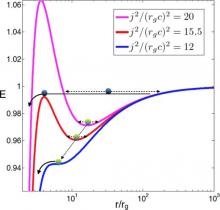
Abstract
Models for tidal disruption events (TDEs) in which a supermassive black hole disrupts a star commonly assume that the highly eccentric streams of bound stellar debris promptly form a circular accretion disc at the pericentre scale. However, the bolometric peak luminosity of most TDE candidates, ∼ 1044 erg s− 1, implies that we observe only ∼1 per cent of the energy expected from radiatively efficient accretion. Even the energy that must be lost to circularize the returning tidal flow is larger than the observed energy. Recently, Piran et al. suggested that the observed optical TDE emission is powered by shocks at the apocentre between freshly infalling material and earlier arriving matter. This model explains the small radiated energy, the low temperature and the large radius implied by the observations as well as the t−5/3 light curve. However the question of the system's low bolometric efficiency remains unanswered. We suggest that the high orbital energy and low angular momentum of the flow make it possible for magnetic stresses to reduce the matter's already small angular momentum to the point at which it can fall ballistically into the supermassive black hole before circularization. As a result, the efficiency is only ∼1–10 per cent of a standard accretion disc's efficiency. Thus, the intrinsically high eccentricity of the tidal debris naturally explains why most TDE candidates are fainter than expected.